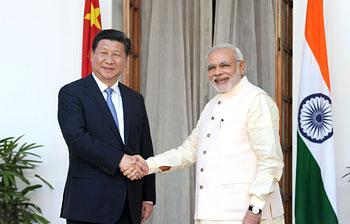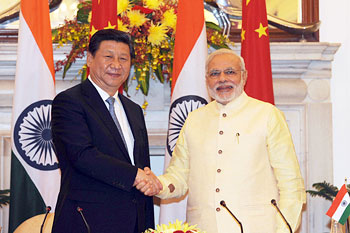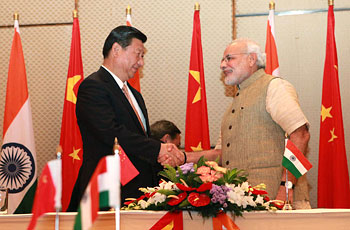INDIAN ARMED FORCES CHIEFS ON OUR RELENTLESS AND FOCUSED PUBLISHING EFFORTS

The insightful articles, inspiring narrations and analytical perspectives presented by the Editorial Team, establish an alluring connect with the reader. My compliments and best wishes to SP Guide Publications.

"Over the past 60 years, the growth of SP Guide Publications has mirrored the rising stature of Indian Navy. Its well-researched and informative magazines on Defence and Aerospace sector have served to shape an educated opinion of our military personnel, policy makers and the public alike. I wish SP's Publication team continued success, fair winds and following seas in all future endeavour!"

Since, its inception in 1964, SP Guide Publications has consistently demonstrated commitment to high-quality journalism in the aerospace and defence sectors, earning a well-deserved reputation as Asia's largest media house in this domain. I wish SP Guide Publications continued success in its pursuit of excellence.
- Prime Minister Modi Visits Punjab’s Adampur Air Base, Interacts with Airmen after Successful ‘Operation Sindoor’; Stern Message to Pakistan
- The layered Air Defence systems that worked superbly, the key element of Operation Sindoor
- Operation Sindoor | Day 2 DGMOs Briefing
- Operation Sindoor: India strikes back with Precision and Purpose
- Operation Sindoor: Resolute yet Restrained
- India’s Operation Sindoor Sends a Clear Message to Terror and the World – ‘ZERO TOLERANCE’
- Japan and India set forth a defence cooperation consultancy framework, talks on tank and jet engines
- Terrorist Attack in Pahalgam in Kashmir: Unfolding a long surgical war against PAK
- Lt General Pratik Sharma takes over Command of Indian Army's Northern Command
India China — Keep talking
The Chinese incursions along the LAC and other forms of provocation on the eve of the Chinese President's visit to India failed to dampen the spirits on both sides of the border resulting in the Chinese commitment of US$20 billion investment in India over the next 5 years.



Amidst renewed incidents of incursions and military standoff in Demchok and Chumar on Ladakh border on the eve of the visit of the Chinese President Xi Jin Ping from 17-19 September, Indian and Chinese leaders conducted their summit deliberations in an atmosphere of camaraderie with frank exchange of each other’s concerns and apprehensions with a deep desire to move the relations forward. Inspite of the hype in the diplomatic circles, both in China and India, the visit did not result in any landmark breakthrough but some major agreements in the economic arena will definitely give a push to bilateral relations as the two neighbors also agreed to carry forward the momentum of the dialogue and summit level interactions. The leaders thus have displayed the maturity to not allow the tensions on the ground to transform into a direct conflict situation. In fact the shadow of the incursion did not affect the talks and the sentiments on the two sides to go ahead with the economic cooperation agenda, which resulted in five year economic programme, envisaging an investment of over US$ 20 billion and a decision to develop two Industrial Parks in Ahmedabad and Pune, which will attract investments over US$7 billion.
Bilateral trade relations between the two countries have been deepening inspite of some pinpricks along the 4000 Kms long Line Of Actual Control. And probably to reduce the pain, the two armed forces and defence officials on both sides will be asked to exchange pleasantries, with an aim to repose faith on each other. The two armies are heavily armed on the border and equipped with nuclear forces, hence the two countries have displayed wisdom by establishing several confidence building mechanisms in the course of last few years and the two leaders have now decided to encourage the high-level regular meeting of top military leaders and defence officials. The Modi-Xi confabulations have resulted in the expansion of military contacts, exchanges and joint programmes, all of which will probably help in clearing many cobwebs in the minds of the two militaries in the coming years. The two armies would soon be holding a joint exercise in India in October called Hand-in-Hand. The scope of joint military interactions has now been expanded to Air Force and Navy. In fact the Navies of the two countries had first direct exchanges and goodwill visits to each other’s naval bases early last decade , which created warmth and raised the confidence level among the two navies. There was also a proposal to initiate joint Air Force exercise in the middle of last decade, but could not move forward. Even the Indian Air Force acrobatics team Suryakiran was invited to showcase its capabilities during Zhu Hai air show in 2007 in front of the Chinese forces and international military delegations. The first joint army exercise was held in Kunming (China) in 2008 and the return leg was hosted at the Indian army cantonment in Belgaum in Karnataka in 2009. The third exercise was called off in view of the new Staple Visa policy for the residents of Jammu and Kashmir. This was resumed in 2013 when Indian army team again visited Chinese city of Chengdu for third series of Hand-in-Hand exercise. Now the fourth round, in this series of joint exercises, has been cleared by the two leaders.
The visit did not result in any landmark breakthrough but some major agreements in the economic arena will definitely give a push to bilateral relations
The momentum received a jolt , when in 2010 , the Chinese government tried to humiliate the Chief of the then Northern Army command Lt . General B S Jaswal , who was to lead the military delegation by issuing him a staple visa. Indian government retaliated by canceling the official trip and the relations cooled thereafter. The relations warmed up again when the Chinese agreed to stop issuing Staple Visa for the Kashmiris.
However, as the situation stands now, China has shown no signs of relenting on the border issue. The Joint Statement issued after the conclusion of the visit conceals more than it reveals. That China expects other countries to express solidarity with its One China Policy, incorporating Tibet and Taiwan is well known and following on the footsteps of the previous UPA government, the NDA government also asked One India Policy to be incorporated in the Joint Statement. Indian diplomats enunciate One India Policy as incorporating Arunachal Pradesh and Jammu and Kashmir. Thus the joint statement also failed to mention in explicit words, China’s One China Policy. India has been refusing to endorse this in the Joint Statements since 2010, ever since China started issuing the Staple Visa for Jammu and Kashmir. India’s stand was very blunt- accept the formulation of One India Policy incorporating the Arunachal Pradesh and Jammu and Kashmir in one India policy.
China and India interactions indicated the tough bargaining at Hyderabad House and both Modi and Xi expressed strong opinions on economic, territorial dispute and other issues
To avoid any confrontation on the border the two countries in the Joint Statement issued one day after the Summit meeting, said, “ Peace and tranquility on the India-China border areas was recognized as an important guarantor for the development and continued growth of bilateral relations. Pending a final resolution of the boundary question, the two sides would continue to make joint efforts to maintain peace and tranquility in the border areas.”
According to Dr Srikanth Kondapalli , noted China expert, “China and India interactions indicated the tough bargaining at Hyderabad House and both Modi and Xi expressed strong opinions on economic, territorial dispute and other issues. While China was the first to reach out to Modi after his elections — reflected in Premier Li Keqiang's phone call in May, foreign minister Wang Yi's visit in June and the BRICS interaction on July 14 — China's diplomatic initiatives faced a challenge as Maritime Silk Road was not endorsed; Bangladesh-India-China-Myanmar Economic corridor was conditionally accepted provided it ensures "peaceful, stable and cooperative environment".
Commenting on the visit, strategic affairs analyst Gurmeet Kanwal said , “ we had unrealistic expectations form the visit. China is interested only in trade and influence. China has carefully planned strategic encirclement of India. China would like to confine India to backwaters of Indian Ocean as subaltern state. China will never accept India as co-equal Asian power . China has no desire to resolve territorial dispute and would like to extract concessions like Tawang.
Interestingly the two sides decided to hold the first round of maritime cooperation dialogue within this year to exchange views on maritime affairs and security, including anti-piracy, freedom of navigation and cooperation between maritime agencies of both countries. They also agreed to hold the consultations on disarmament, non-proliferation and arms control at an early date. In view of India’s publicly aired views on the South China Sea for maintenance of freedom of navigation , the maritime dialogue would be a good occasion to tell the Chinese to keep the maritime area free from territorial encroachment.
Interestingly the two sides decided to hold the first round of maritime cooperation dialogue within this year to exchange views on maritime affairs and security, including anti-piracy, freedom of navigation and cooperation between maritime agencies of both countries
One of the principal agenda of the Chinese President was to promote his maritime diplomacy under the garb of economic cooperation by reviving the age old trade routes known as Maritime Silk Route. The maritime dialogue would be a proper forum to discuss these initiatives. There are apprehensions in India over hidden Chinese agenda to promote its strategic interests in the coastal Indian Ocean from South Asia to Africa and Europe. Hence the Joint Statement released after the Xi Jin Ping visit could not find a paragraph for this important initiative from Chinese viewpoint. The Chinese must have been disheartened over India’s stand that this kind of initiatives can succeed only in the environment of mutual trust , which can be generated only after the two sides resolve the border imbroglio. However India did gave a go ahead signal , on the other Chinese proposal the BCIM economic corridor( touted as Southern Silk Road in China) but without fully committing to the idea.
Interestingly the two rival nations in space and nuclear field have decided to work together in space and nuclear arena, for which the cooperation agreements have been signed. For the cooperation in nuclear sector the two sides declared that as large developing countries committed to promoting the use of clean energy. Both countries believe that expansion of civil nuclear energy program is an essential component of their national energy plans to ensure energy security. The two sides will carry out bilateral cooperation in civil nuclear energy in line with their respective international commitments, including working level consultations between the Department of Atomic Energy of India and the China Atomic Energy Authority. Similarly in the space arena, the two sides have taken an extremely significant decision to cooperate.
On the strength of serious intent to cooperate not only in deepening economic ties but also find new area of cooperation , till now considered sensitive by both sides , one can derive satisfaction from the following declaration in the Joint Statement that both sides are willing to proactively resolve all outstanding differences based on the Five Principles of Peaceful Coexistence through friendly negotiation without letting them affect the overall development of bilateral relations. The two sides reaffirmed their commitment to consolidate the Strategic and Cooperative Partnership for Peace and Prosperity on the basis of the principle of mutual and equal security and mutual sensitivity for each other's concerns and aspirations. Though it is difficult to say that the two rival nations would soon reach an agreement on settling the boundary and territorial disputes, on the basis of above commitments, the more the two nations get closer in economic arena , the chances of early resolution of the disputed issues will get brighter.





